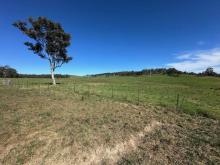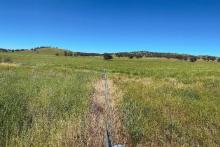Thunderbird Resources is on the hunt for large gold-antimony deposits in New South Wales and has prioritised its exploration focus on ground within several of Australia’s most noteworthy orogenic belts. The company pivoted its exploration efforts this year to focus on gold-copper-antimony and recently jumped at the chance to lock-in its now-flagship Springfield gold deposit, part of the Slashers Flat project near Gulgong in NSW.


Thunderbird Resources, known largely for its pursuit of Canadian uranium, is on the hunt for large gold-antimony deposits in New South Wales and has picked up ground within several of Australia’s most noteworthy orogenic belts.
The company pivoted its exploration efforts this year to focus on gold, copper and antimony and recently jumped at the chance to lock-in its now-flagship Springfield gold prospect, part of its Slashers Flat project near Gulgong in NSW.
Springfield sits within NSW’S renowned Lachlan Orogen, or Lachlan Fold Belt, home to massive gold operations like Newmont Mining’s revered Cadia deposit, which contains mine reserves totalling an eye-boggling 14.1 million-ounces of gold and 3.1 million tonnes of copper.
Springfield complements Thunderbird’s Kookabookra and Rockvale gold-antimony projects in the New England Orogen, also in NSW and it is close to Australia’s largest antimony operation, Larvotto Resources’ Hillgrove deposit.
Thunderbird recently acquired Springfield and immediately locked-in a $2.2 million placement to fuel its exploration blitz, planned for the coming months.
The acquisition sets in train a focus on local critical and precious metals projects for in-demand assets such as antimony, copper and gold.
Historic drilling at Springfield has thrown up some serious looking shallow gold results such as 27m at 3.65 grams per tonne (g/t) from surface, a 65m stretch going 1.16g/t from 2m and 41m running 1.47g/t from 22m.
A deeper interval of 86m at 1.04g/t from 104m included a 26m section grading 1.83g/t from 146m and a solid 12m slice at 2.9g/t from 160m.
Management says there has been only limited historical shallow drilling of a minimal 6568-metres at Springfield, with previous mapping delineating a well-mineralised intrusion extending for more than 1700m in strike length. The company says the mineralisation remains open in both directions, along strike and at depth and notably, only 500m of the 1700m strike length has been subjected to deeper drilling, with no drilling on site since 1999.
Significant mineralisation has also been intersected at depth across the entire 500m strike length tested to-date and the company plans to launch into its maiden drill program at the project shortly after completion of the purchase, expected to be before the end of November.
A previous 186 drillholes averaging 35m were hammered into the Springfield and Springfield North deposits, with the deepest hole drilled to a depth of 249.1m.
Mineralised hits worthy of follow-up have occurred at multiple prospects within Slashers Flat. They include Springfield North’s shallow gold hits of 2m at 1.43g/t from 13m and 1m going 1.12g/t from 10m, Lady Belmore’s 5m at 1.4g/t gold from 5m and 5m at 1.09g/t gold from 20m.
The Divide 4 prospect returned 1m at 1.63g/t gold from 21m and a 1m slice grading 1.35g/t gold from 11m, providing further sniffs for follow up.
Thunderbird purchased the unlisted company LM2 Pty Ltd to acquire Springfield, with the added benefit of pumping up its exploration ground by a significant 344 square kilometres. LM2 holds five granted exploration licences in central and northern NSW.
In addition to Slashers Flat, three of the other projects are also based in the Lachlan Orogen, a geological zone of folded and faulted rocks, stretching across New South Wales, Victoria and eastern Tasmania.
In addition to the massive Cadia deposit, the Lachlan Orogen hosts North Parkes’ 2.6 million ounce gold and 2.3 million tonne copper operation and the 9 million-ounce Cowal gold deposit.
The company is making excellent progress with land access agreements for Springfield, anticipating the establishment of a new agreement in the next few weeks. A systematic, project-wide soil sampling program will then take place, expected to commence mid-November.
When assay results are received and the highest-priority targets are locked-in, plans are for a 2500m reverse-circulation drilling program to be punched into the promising ground from mid-January next year.
The prime mover and architect of Thunderbird’s pivot into NSW gold and antimony is Mike Haynes.
In late August 2024 after seven years at the helm, Haynes transitioned from managing director to non-executive director at US copper developer, New World Resources.
When Kinterra Capital came knocking for New World’s Antler copper project in May with its cheque book wide open, eventually winning a bidding war with Central Asia Metals (CAML) by paying about $250 million, Haynes turned his attention to Thunderbird.
A geologist and geophysicist, he returned to his exploration roots in search for land prospective for gold and packaged together the promising Kookabookra and Rockvale gold-antimony projects near Larvotto and vended them into Thunderbird.
The two projects cover a combined 488 square kilometres, with Rockvale almost within shouting distance of Larvotto Resources’ outstanding Hillgrove project.
In fact, the new Rockvale ground almost circles the adjacent Hillgrove project which has Australia’s largest antimony resource of 96,000 tonnes and a 1.135-million-ounce gold resource. The two combine for a gold-equivalent resource of 1.7M ounces at a stellar gold-equivalent grade of 7.4g/t.
The projects sit near the town of Armidale in northern New South Wales.
Hillgrove has seen plenty of news lately too, as it navigates the new critical minerals market fever led by the US Whitehouse.
The United States Antimony Corporation recently lobbed an offer at Larvotto shareholders, valuing Larvotto at more than $700 million. The bid was rejected by Larvotto management.
Thunderbird has moved quickly to gain access to high-priority targets at the two northeastern New South Wales projects based on a historical data review where high-grade gold, silver and antimony were previously identified.
Significant assay results of 19.3g/t and 8.56g/t gold were returned from rock chips at Kookabookra, along with 4.12 per cent antimony, while at Rockvale, 200g/t silver in rock chips was discovered.
Thunderbird has plans to also complete soil sampling and detailed mapping at its Achill prospect within Rockvale, in addition to testing multiple other targets at the site.
Achill is already the site of a high-grade antimony find, having disseminated stibnite (antimony) of 1-2 per cent observed within quartz veins. Rock chip assays have returned up to 0.89g/t and silver going 200g/t.
The sampling identified antimony occurrences trending north to south over a 130-metre strike length, open to the north, where it is interpreted to continue under cover. It also remains open to the south.
Thunderbird’s Taits Gully prospect has various historical workings, including the Mary-Ann mine. Samples of material at the mine dump assayed up to 110g/t silver and 1.76g/t gold.
Rockvale sits between two north-east trending regional-scale faults, the Chandler fault and the Hillgrove fault. The faults are believed to provide important controls on the mineralisation at the nearby Hillgrove project.
Thunderbird ploughed ahead with further exploration at Kookabookra and looks to have zeroed in on high-grade gold mineralisation, with rock chip assays returning up to a spectacular 153.5g/t gold at the company’s Mt Secret prospect.
Management says the results, coupled with robust soil sampling and an ongoing induced polarisation (IP) survey, will direct a maiden drilling program at the recently acquired project early next year that will no doubt be highly anticipated.
The 153.5g/t gold assays came in alongside 16.35g/t silver and some solid pathfinder results for bismuth and molybdenum, all of which points to what management believes is an intrusion-related gold system (IRGS).
IRGS’s hold the key to some of Australia’s largest recent gold discoveries, with parallels to multi-million-ounce giants such as De Grey’s Hemi gold project, acquired for a massive $5 billion by Northern Star Resources and the five-million-ounce Kidston deposit in Queensland.
Thunderbird believes the high-grade mineralisation within its ground is tied to quartz veins and altered granite. One to two per cent sulphides are accompanied by a strong pathfinder signature typical of IRGS deposits.
Soil sampling results have unveiled two substantial gold-in-soil anomalies at Mt Secret and the Mannix prospects to the south.
At Mannix, an irregular 600m by 600m anomaly returned assays up to 926 parts per billion (ppb) gold, while Mt Secret revealed a 200m-long north-south trending anomaly with a peak of 282ppb gold. The results are centred around historical workings, which the company says confirm a significant mineralised system that remains untested at depth.
Thunderbird has now completed a further program of 39 rock chip and grab samples, including initial sampling from several historical prospects not previously sampled by the company, such as the Bear Hill and Butchers Reef areas.
The impressive results kicked up a range of new target areas, with gold assay results of 17.35g/t at Bear Hill, 2.79g/t at Butchers Reef, 32.1g/t at the Columbo prospect and a solid 20.7g/t at German Reef.
Additionally, a sample from the Nuggety Gully Reef area produced a 4.52g/t result, adding to the stellar suite of new prospective areas for the company to probe with further exploration techniques.
Thunderbird completed an induced polarisation (IP) survey across its Mt Secret and Mannix prospects to help define new drill targets. The results will be added to the company’s rock chip and geochemical soil sampling and geological mapping programs to plan a maiden drilling program at Kookabookra, potentially in the first half of next year.
Notably, at the Columbo prospect, a previously undocumented line of historical mine workings returned several rock chip results grading more than 1g/t. Follow-up plans for that prospect include geochemical soil sampling and detailed geological mapping.
The company recently completed a review of publicly available light detection and ranging (LiDAR) survey data across Kookabookra.
The use of LiDAR aerial surveys provides high-resolution aerial photography and a “bare earth” terrain view, which strips away vegetation and reveals the geology and structural details underneath, capturing valuable imagery.
The company’s interpretation of the data identified an eye-opening 428 historical mine workings, comprising 40 adits, 40 shafts and 348 shallow prospecting pits, and revealed 228 trenches, providing a plethora of new potential targets.
Two other projects wrapped up in the Springfield purchase, Shanahans and Warrane, are situated within the New England Orogen, known for hosting high-grade gold and antimony projects like the Hillgrove deposit.
The run-up in the price of antimony, due to China imposing export restrictions on the critical mineral vital for use in defence applications, caused Larvotto’s share price to hike by almost 1000 per cent last year.
At Rockvale, management plans to organise a soil sampling program late this year or in January, to home-in on potential target areas to drill. Assays are expected in February or March, setting up a possible drilling program in the first half of next year.
After a concerted uranium push in Canada under previous management, the company has chosen to joint-venture its most promising uranium projects. The Surprise Creek and Cluff Lake North projects are currently held in JV with Canadian Securities Exchange-listed Mustang Energy Corporation, providing Mustang with the opportunity to earn up to an 80 per cent interest in the projects.
Thunderbird retains an 80 per cent interest in the Hook Lake uranium project, from its own earn-in JV with Canadian firm Skyharbour Resources.
The company revealed a change of name will soon be made, subject to a shareholder vote at the upcoming annual general meeting, scheduled for November 19.
Xpedra Resources Ltd is its proposed new name.
Thunderbird’s biggest problem in NSW is working out where to sink the drill bit first. There is no doubt that its various projects and prospects are well endowed with minerals, the big question however is where to spend the money now to get the best bang for buck.
Is your ASX-listed company doing something interesting? Contact: matt.birney@businessnews.com.au













